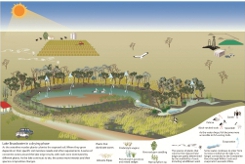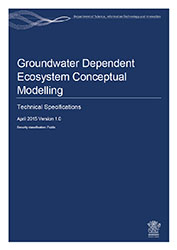|
|
Pictorial conceptual modelsPictorial conceptual models—also known as conceptual diagrams or models—use drawings and diagrams to explain how a wetland works. The models are powerful tools as they offer a way of visualising complex environmental processes. They can easily be used by a variety of audiences with varying levels of knowledge. Pictures worth a thousand words: A guide to pictorial conceptual modelling provides natural resource managers with a step-by-step approach to developing and applying pictorial conceptual models for better management outcomes. Quick facts
Guide to pictorial conceptual modelling
The Guide to pictorial conceptual modelling was developed to support wetland ecosystem science and management in Queensland. The guide draws on the experience developed through the Program on how to synthesise and communicate complex scientific ideas to diverse and often non-scientific audiences. The guide explores the use of pictorial conceptual modelling to inform wetland management and engage the broader wetland community, and provides a step-by-step process for developing these types of models. Pictorial conceptual modelling has been developed as a suite of knowledge visualisation practices to help ensure that scientific knowledge is used for greater benefit to people and the environment. With this broad aim in mind, pictorial conceptual models aid communication among natural resource managers, scientists and the community, especially in environmental management. The Queensland Wetlands Program, along with affiliated Queensland Government agencies and other stakeholders, has used pictorial conceptual modelling very effectively for communicating wetland science to decision makers. Some resulting wetland conceptual models include:
Conceptual model resources Pictures worth a thousand words: A guide to pictorial conceptual modelling. The guide explores the use of pictorial conceptual modelling to inform wetland management and engage the broader wetland community. A step-by-step process for developing pictorial conceptual models is presented, along with flow charts and checklists for managing each step.  Groundwater Dependent Ecosystem Conceptual modelling. This is a guide to the process for developing, publishing and distributing groundwater dependent ecosystems (GDEs) conceptual models developed by the Queensland Government. The Adobe Illustrator software can be used to create icons and conceptual models. The IAN symbol libraries contain over 1500 custom-made vector symbols (in 32 categories) designed specifically for enhancing science communication skills. The libraries are designed primarily for use with Adobe Illustrator (requires version 10 or later). However EPS and SVG versions are also available for non-Illustrator users. The symbols allow diagrammatic representations of complex processes to be developed easily with minimal graphical skills. The OzCoast website provides information about the use of conceptual modelling. Conceptual model templates have been developed for the seven different types of estuaries and coastal waterways. This will allow users to represent the causal pressures in their catchment and the stressors that impact upon their waterway. eWater has a tool, Concept, that is used to create dynamic conceptual diagrams. It is a drawing package that allows the user to display the important elements of a scenario in a visually appealing way and show the links between these elements. The links can have relationships associated with them and these relationships can be changed dynamically to show changed conditions for the elements under different scenarios. The software can be used to model many situations, e.g. communicating processes and scenarios, identifying and involving stakeholders, consensus building, issues scoping and prioritising. Communicating_Science_Effectively:_A_Practical_Handbook_for_Integrating_Visual Elements_2006 is a practical handbook on how to communicate science effectively. The first part is an introduction to the principles of science communication—identifying effective science communication, why it is important, and how it is done. The principles in these chapters include how effective science communication can change how society thinks and helps produce better scientists. Additional informationReferences
Last updated: 22 March 2013 This page should be cited as: Department of Environment, Science and Innovation, Queensland (2013) Pictorial conceptual models , WetlandInfo website, accessed 8 May 2025. Available at: https://wetlandinfo.des.qld.gov.au/wetlands/resources/pictorial-conceptual-models.html |

 — Department of the Environment, Tourism, Science and Innovation
— Department of the Environment, Tourism, Science and Innovation

